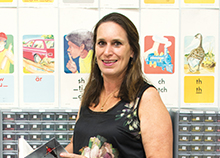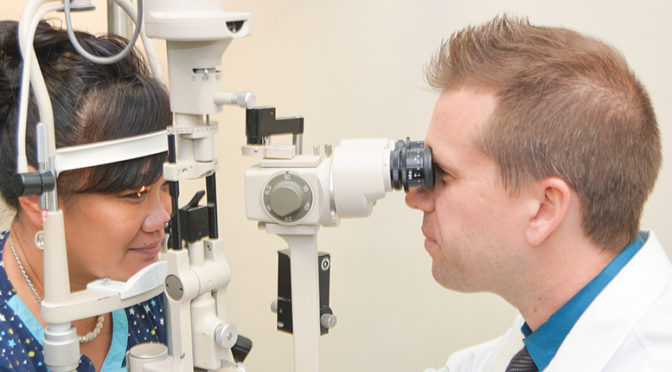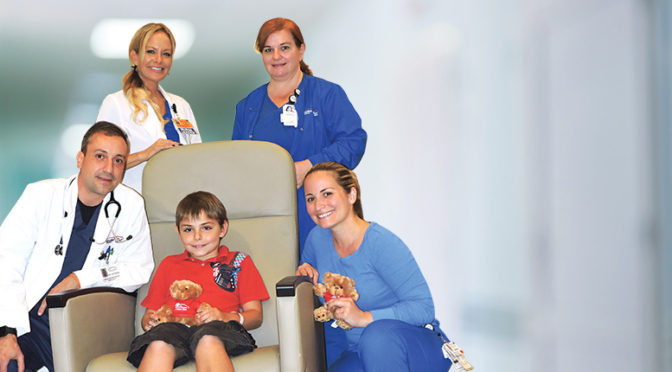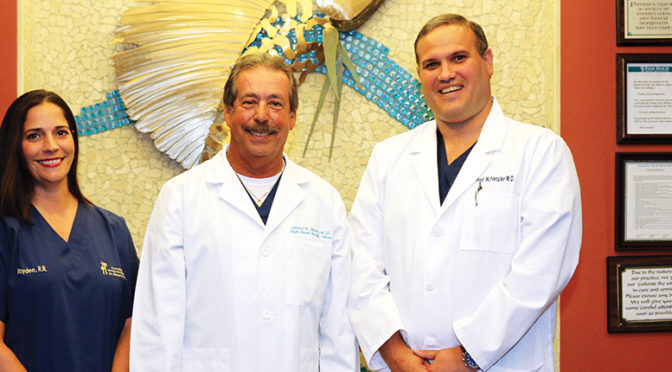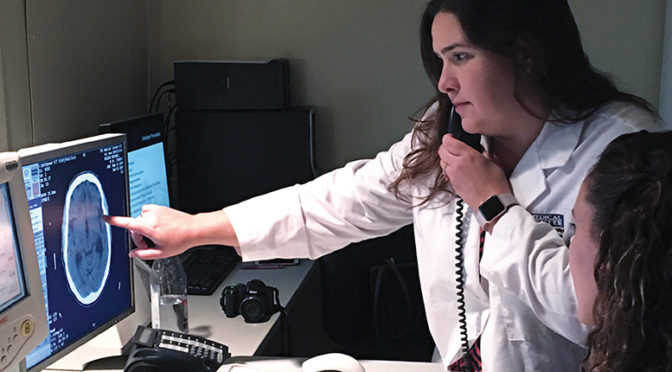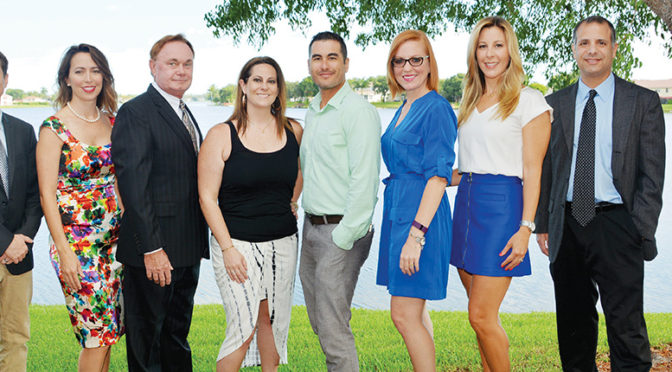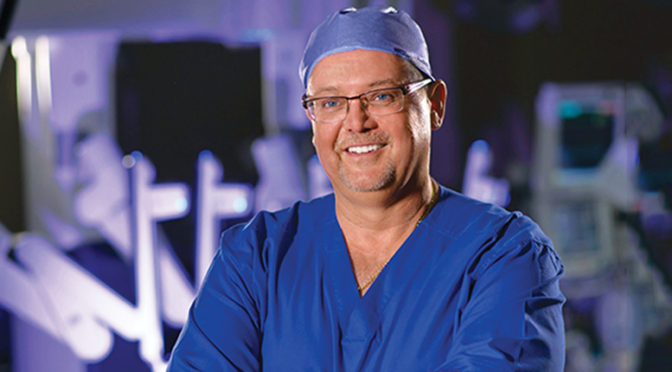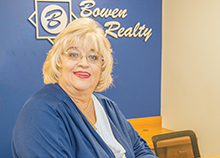Wellington The Magazine-July 2016
Technological Improvements Spur Advances In Many Medical Specialties
Story by Deborah Welky • Photos by Abner Pedraza
As in most industries, astounding technological advances are being made in the medical field, and changes brought by this technology span all healthcare specialties. To learn more about these improvements, Wellington The Magazine spoke to local experts in the fields of orthopedics, ophthalmology and plastic surgery about the changes that will help patients take on once-daunting issues with a new level of confidence.
Dr. Harvey Montijo, CEO of the Center for Bone & Joint Surgery of the Palm Beaches (www.boneandjoint.org), has good news for his patients. Advances in methods of hip replacement have made his biggest problem “slowing the patients down.”
“They have no pain, no fear. I had a patient who went out two weeks after her hip replacement and played 18 holes of golf,” he recalled “However, the femur needs more than two weeks to grab onto the titanium stem. I had to ask her to back off.”
That patient was able to take advantage of the latest technology in hip replacements — the anterior (side) approach to hip surgery.
“This is now possible due to the Hana table,” Montijo said, referring to a state-of-the-art fracture table that features unique patient positioning capabilities, enabling the surgeon to replace the hip through a single incision without detachment of muscle from the pelvis or femur.
“The classical posterior surgery left the patient with a limp for the first four or five weeks,” Montijo said. “Now, there’s no limp, and the patients leave the hospital the next day. Soon, anterior hip replacement will be done on an outpatient basis.”
Because the procedure no longer needs to cut through half the muscle, there is significantly less pain.
“There is less of a need for narcotics and, therefore, less of a problem with narcotic side effects like constipation and hallucinations,” Montijo said. “My patients can go to rehab within 24 to 48 hours. Before, it took several days to get to that point.”
Montijo uses the anterior approach on about 50 percent of the hips he works on. Unfortunately, the method is not possible for revision work.
“The anterior approach is a little more labor-intensive for the surgeon, but it’s worth the effort for the patients,” he explained. “It’s delightful to see my patients recover so quickly.”
In addition to hip replacements, the Center for Bone & Joint Surgery offers specialized orthopedic treatments that include arthroscopy, joint reconstruction, ankle replacements, knee and shoulder replacements, as well as trauma and fracture repair. The center also treats sports-related injuries of the hand, wrist, foot and ankle, as well as injuries involving the musculoskeletal system.
Montijo is also the medical director of the Total Joint Center at Wellington Regional Medical Center and member of the hospital’s board of directors. In addition, he is the founder of the Optimal Wellness & Longevity Institute. A U.S. Army veteran, he trains orthopedic surgeons throughout the United States and around the world.
Dr. Jason Gorscak of the Florida Eye Microsurgical Institute (www.fleyedocs.com) is one of the first ophthalmologists in South Florida to offer bladeless cataract surgery using lasers, a technological advance that he has been able to offer since January.
“As far as technology, it’s the hot thing right now,” Gorscak said. “In the past, little blades were used, but now we do it all with a femtosecond laser. This brand-new technology provides more accuracy and more precision. Patients are happier because this laser technology allows us to perform cataract surgery without the use of any blades. Plus, we get better outcomes. The recovery time is a little bit quicker, and there is usually less inflammation, less chance of infection and more clarity of vision.”
The femtosecond laser is a complete anterior segment cataract workstation designed to make clean, geometrically pristine incisions on every plane of the anterior chamber. The system’s variable numerical aperture design adjusts the beam to the specific target tissue and depth, increasing precision and efficiency. The laser’s versatile fragmentation patterns and combinations are designed to optimize procedures. In addition, it is customizable for challenging lens densities.
The technology has only been commercially available for about two years.
“Not many practices have this technology yet,” Gorscak said. “We’re one of only a couple in South Florida. We were lucky enough to be able to get one. Using femtosecond laser technology has brought about a new level of precision and accuracy to the visual outcomes of our patients following cataract surgery. They could not be more satisfied with the quality of vision that they obtain following surgery. I am extremely happy that we now have this technology available for our patients.”
While Gorscak diagnoses and treats cataract conditions, he also focuses on glaucoma and diabetic retinopathy, and specializes in diagnosing and removing both benign and malignant tumors of the eyelids.
He’s part of the team at Florida Eye Microsurgical Institute, which includes a staff of more than 75 professionals, from board-certified physicians to nurses and medical technicians. Together, they offer a full range of comprehensive ophthalmologic care — routine eye care and examinations, pediatric eye care, pediatric and adult strabismus care, and dry eye treatments, as well as advanced corneal, retinal and cataract procedures.
Dr. Jeffrey Wisnicki of the Advanced Cosmetic Surgery Center (www.drwisnicki.com) is a western communities pioneer who is now known as one of the top plastic surgeons in Florida. Chosen by his peers, he is featured in the nonprofit consumer research book, Guide to Top Doctors, which lists those specialists who other doctors would want to care for one of their loved ones.
“Breast enlargement with implants has consistently been one of the top cosmetic surgical procedures among women,” Wisnicki said. “Over the past 20 years, the number of women having the procedure has more than tripled. It is estimated that 5 percent of the female population of the United States have breast implants. The rise in its popularity has been attended by innovation in both the quantity and quality of implant options.”
Breast implants fall into two categories — those filled with silicone gel and those filled with saline or salt water. Both have a silicone wall which contains the fill material. Wisnicki explained that the first silicone gel-filled implants were placed in a patient in 1962, followed two years later by the clinical use of the saline-filled implants. Both procedures have now been perfected, he said.
“Shell strength has improved for all breast implants. The silicone gel currently used has greater cohesiveness, meaning it has less of a liquid characteristic. What are referred to as fourth- and fifth-generation silicone-filled implants are now used depending on the particular needs of the individual, and these are designed to reproduce the feel of breast tissue,” he said, noting that manufacturers offer a selection of sizes, shapes and profiles never before available. “Many women may opt for enhancement with saline-filled implants for a variety of reasons, including a smaller scar and no need for MRI monitoring of implant integrity as recommended by the FDA with the silicone-filled devices.”
A new alternative has arrived with the recent development of the Ideal Implant Structured Breast Implant. “It is a redesign of the saline implant that includes an internal structure of baffle shells, which limits fluid movement,” Wisnicki said. “This again provides an implant feel which more closely approximates breast tissue. While more expensive than traditional saline-filled implants, it may provide a more appealing solution for some women who, despite its safety record, want to avoid silicone gel.”
Wisnicki was one of the original investigators in clinical trials that led to FDA approval of the Ideal Implant for use in 2014, after gathering five years of supportive data.
“An attempt to reduce the potential mechanical stress of implants on the body may be found in the B-Lite Lightweight Breast Implants, which are used in Europe but are not approved for use in the United States at this time,” he said, noting that clinical studies are ongoing. “Tiny hollow spheres, or microspheres, are suspended within a cohesive gel to reduce implant weight by up to 30 percent.”
Wisnicki recommends that potential breast implant patients meet with a board-certified plastic surgeon to learn more.
“With so many alternatives available, a thorough consultation with a board-certified plastic surgeon becomes all the more important, as the best approach for the individual patient may not always be clear,” Wisnicki said. “What is clear is that breast implant technology continues to improve under the umbrella of careful basic and clinical science.”




